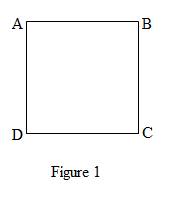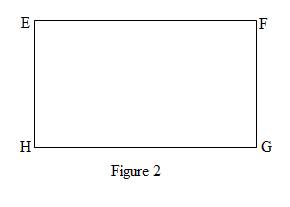
Students sometimes get confused about the relationship between squares and rectangles. Explain this relationship In your own words, using our (short) definitions of these shapes
To explain: The relationship between squares and rectangles.
Explanation of Solution
Consider a square shown in Figure 1.

The above Figure 1 represents square ABCD.
The sides of square AB, BC,CD, and DA are equal.
Consider a rectangle shown in Figure 2.

The above Figure 2 represents rectangle EFGH.
The sides of square EF, GH are length of the rectangle and are equal in size.
The sides of square EH, FG is breadth of the rectangle and is equal in size.
All angles of rectangle are right angle.
Therefore, it can be observed that the square has all side equals and every angle form right angle similar to rectangle.
Therefore, every rectangle can be square but every square cannot be rectangle.
Want to see more full solutions like this?
Chapter 10 Solutions
EBK MATHEMATICS FOR ELEMENTARY TEACHERS
Additional Math Textbook Solutions
Finite Mathematics for Business, Economics, Life Sciences and Social Sciences
Pathways To Math Literacy (looseleaf)
Precalculus: A Unit Circle Approach (3rd Edition)
College Algebra (Collegiate Math)
Precalculus
Elementary Algebra For College Students (10th Edition)
- 9arrow_forward8arrow_forward74. Geometry of implicit differentiation Suppose x and y are related 0. Interpret the solution of this equa- by the equation F(x, y) = tion as the set of points (x, y) that lie on the intersection of the F(x, y) with the xy-plane (z = 0). surface Z = a. Make a sketch of a surface and its intersection with the xy-plane. Give a geometric interpretation of the result that dy dx = Fx F χ y b. Explain geometrically what happens at points where F = 0. yarrow_forward
- Example 3.2. Solve the following boundary value problem by ADM (Adomian decomposition) method with the boundary conditions მი მი z- = 2x²+3 дг Əz w(x, 0) = x² - 3x, θω (x, 0) = i(2x+3). ayarrow_forward6. A particle moves according to a law of motion s(t) = t3-12t2 + 36t, where t is measured in seconds and s is in feet. (a) What is the velocity at time t? (b) What is the velocity after 3 s? (c) When is the particle at rest? (d) When is the particle moving in the positive direction? (e) What is the acceleration at time t? (f) What is the acceleration after 3 s?arrow_forwardpls help asaparrow_forward
- Q1.4 1 Point V=C(R), the vector space of all real-valued continuous functions whose domain is the set R of all real numbers, and H is the subset of C(R) consisting of all of the constant functions. (e.g. the function ƒ : R → R defined by the formula f(x) = 3 for all x E R is an example of one element of H.) OH is a subspace of V. H is not a subspace of V. Save Answerarrow_forwardSolve the following LP problem using the Extreme Point Theorem: Subject to: Maximize Z-6+4y 2+y≤8 2x + y ≤10 2,y20 Solve it using the graphical method. Guidelines for preparation for the teacher's questions: Understand the basics of Linear Programming (LP) 1. Know how to formulate an LP model. 2. Be able to identify decision variables, objective functions, and constraints. Be comfortable with graphical solutions 3. Know how to plot feasible regions and find extreme points. 4. Understand how constraints affect the solution space. Understand the Extreme Point Theorem 5. Know why solutions always occur at extreme points. 6. Be able to explain how optimization changes with different constraints. Think about real-world implications 7. Consider how removing or modifying constraints affects the solution. 8. Be prepared to explain why LP problems are used in business, economics, and operations research.arrow_forwardConstruct a table and find the indicated limit. √√x+2 If h(x) = then find lim h(x). X-8 X-8 Complete the table below. X 7.9 h(x) 7.99 7.999 8.001 8.01 8.1 (Type integers or decimals rounded to four decimal places as needed.)arrow_forward
- Example 3.2. Solve the following boundary value problem by ADM (Adomian decomposition) method with the boundary conditions მი მი z- = 2x²+3 дг Əz w(x, 0) = x² - 3x, θω (x, 0) = i(2x+3). ayarrow_forwardUse the graph to find the following limits. (a) lim f(x) (b) lim f(x) X-1 x→1 (a) Find lim f(x) or state that it does not exist. Select the correct choice X-1 below and, if necessary, fill in the answer box within your choice. OA. lim f(x) = X-1 (Round to the nearest integer as needed.) OB. The limit does not exist. Qarrow_forwardOfficials in a certain region tend to raise the sales tax in years in which the state faces a budget deficit and then cut the tax when the state has a surplus. The graph shows the region's sales tax in recent years. Let T(x) represent the sales tax per dollar spent in year x. Find the desired limits and values, if they exist. Note that '01 represents 2001. Complete parts (a) through (e). Tax (in cents) T(X)4 8.5 8- OA. lim T(x)= cent(s) X-2007 (Type an integer or a decimal.) OB. The limit does not exist and is neither ∞ nor - ∞. Garrow_forward
 Holt Mcdougal Larson Pre-algebra: Student Edition...AlgebraISBN:9780547587776Author:HOLT MCDOUGALPublisher:HOLT MCDOUGAL
Holt Mcdougal Larson Pre-algebra: Student Edition...AlgebraISBN:9780547587776Author:HOLT MCDOUGALPublisher:HOLT MCDOUGAL Trigonometry (MindTap Course List)TrigonometryISBN:9781337278461Author:Ron LarsonPublisher:Cengage Learning
Trigonometry (MindTap Course List)TrigonometryISBN:9781337278461Author:Ron LarsonPublisher:Cengage Learning
 Glencoe Algebra 1, Student Edition, 9780079039897...AlgebraISBN:9780079039897Author:CarterPublisher:McGraw Hill
Glencoe Algebra 1, Student Edition, 9780079039897...AlgebraISBN:9780079039897Author:CarterPublisher:McGraw Hill






